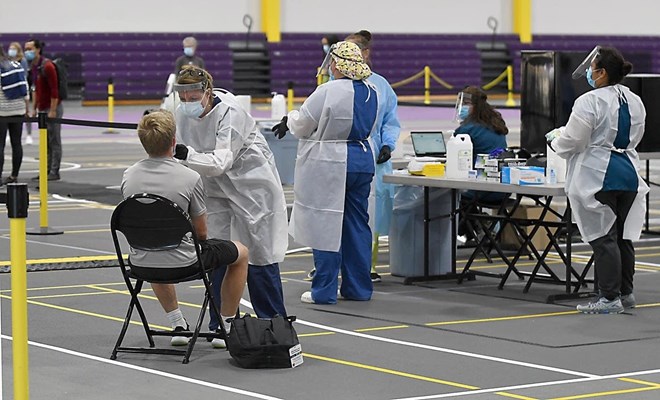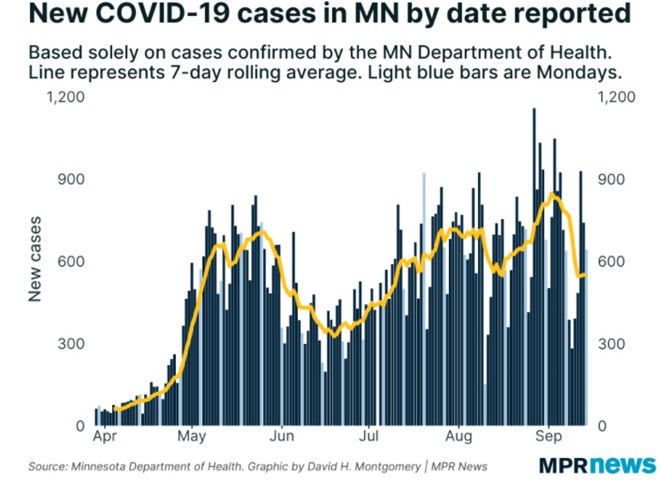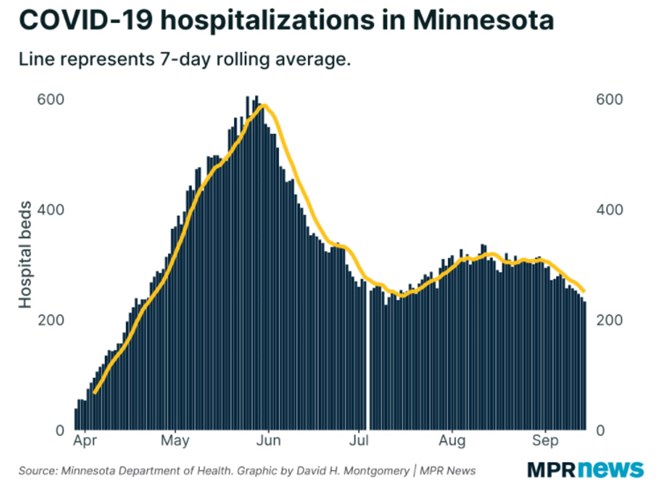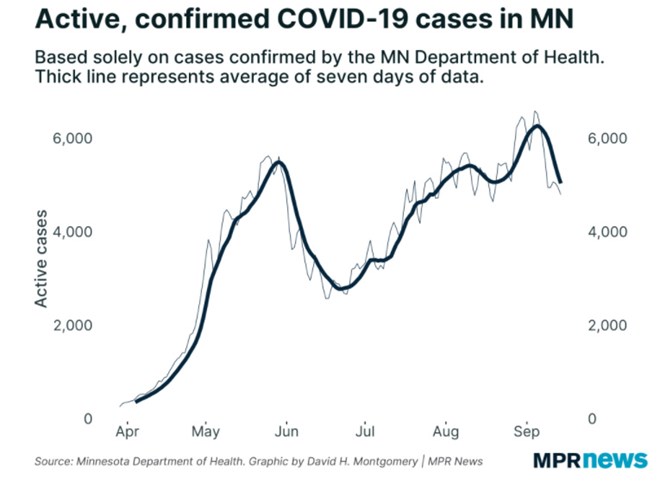Minnesota Department of Health
Wednesday September 16, 2020

A nurse takes a swab from a patient Sept. 2 at the mass testing COVID-19 clinic at Minnesota State University, Mankato's Myers Field House in Mankato, Minn. Pat Christman | Mankato Free Press file
Minnesota’s daily COVID-19 numbers continue to show a familiar recent pattern: relatively moderate case growth and hospitalizations and mostly single-digit deaths. Officials, though, continue to caution that the level of community spread of the virus means more problems ahead.
Wednesday’s Health Department report showed 513 new infections; 244 patients are in the hospital, with 136 needing intensive care. Those hospitalization numbers inched up from Tuesday but the overall trend is down so far in September compared to August.
Hospital patients and ICU cases are two metrics closely watched by department officials as they work to manage the spread of the disease so it doesn’t overwhelm the health care system.
State public health leaders are expected to brief reporters at 2 p.m.
Of the 85,813 confirmed cases of the disease in the pandemic to date, about 91 percent of those identified have recovered to the point they no longer need to be isolated.
Seven more deaths reported Wednesday bring Minnesota’s toll to 1,933. Among those who’ve died, about 73 percent had been living in long-term care or assisted living facilities; nearly all had underlying health problems.
Virus ‘all over the state’
The newest numbers come as officials continue to caution that the level of ongoing community spread of the virus means more problems ahead, despite this period of moderate case growth, relatively stable hospitalizations and mostly single-digit deaths.
Public health authorities have warned community spread, where the origin is not precisely known, is growing in Minnesota, driven by informal get-togethers, weddings, college student meetups and other social events where people aren’t wearing masks, socially distancing or taking other precautions.
“We just really continue to be concerned about the degree of virus that’s prevalent all over the state and the ease with which what’s been a pretty controlled situation could escalate further,” Health Commissioner Jan Malcolm told reporters Monday.
“We’re really walking on the edge of the cliff and we’re grateful that we haven’t fallen off, but we have not moved away from the edge of the cliff,” added Kris Ehresmann, the state’s infectious disease director, tapping an analogy she and Malcolm have used before.
“The potential for going over the edge is still there,” she said.
Health authorities are also asking parents to keep children at home when they’re sick, knowing how difficult that can be for many families, especially single-parent households. They're also asking employers to be understanding.

Health Department investigators this week also plan to go door-to-door in randomly selected neighborhoods in the Twin Cities and southeastern Minnesota as part of a statewide study to find out where COVID-19 is more prevalent.
They’ll ask questions about where people spend time, whether anyone in the house has been diagnosed with COVID-19, and what information they'd like about the virus. They'll also offer free nasal swabs and serology tests.
College campus worries rise
People in their 20s make up the age bracket with the state’s largest number of confirmed cases — topping 20,000 since the pandemic began, including more than 11,500 infections among people ages 20-24.
The numbers help explain why experts remain particularly concerned about young adults as spreaders of the virus.
While less likely to feel the worst effects of the disease, experts worry youth and young adults will spread it to grandparents and other vulnerable populations and could also hamper attempts to reopen campuses completely to in-person teaching.
They’ve been driving the recent outbreaks, although the number of high school-age children confirmed with the disease has also grown, approaching nearly 8,000 total cases for children 15 to 19 years old since the pandemic began.
On Sunday, just across the border from Minnesota, the University of Wisconsin-La Crosse responded to rising cases by moving all in-person classes online, closing dining halls and most campus buildings, and mandating face coverings at all times on campus, indoors or outdoors.
Classes were suspended Monday and Tuesday before resuming online on Wednesday.

The move at UW-La Crosse followed a decision last week at nearby Winona State University in Minnesota to implement an immediate 14-day campus quarantine that will limit all nonessential activities on campus to slow the spread of COVID-19.
Winona State, Concordia College in Moorhead and Minnesota State University Mankato have each seen more than 100 cases tied to the schools and students in the last two weeks, Ehresmann said Monday.
Mankato is starting to see conditions improve, while it’s too early to evaluate moves made by Winona and Concordia to check the spread, she added.
Regionally, southern and central Minnesota and the Twin Cities suburbs have driven much of the increase in new cases while Hennepin and Ramsey counties show some of the slowest case growth in the state.
Hot spots have included southwestern Minnesota, where 75 cases have been traced to a late-August wedding in Lyon County that officials describe now as the state’s largest single social spreader event.
On Monday, Minnesota officials also confirmed an outbreak of 122 cases at the federal women’s prison in Waseca, which they said began when federal authorities transferred people into the facility from outside the state who had COVID-19.

‘Third or fourth inning’ of the pandemic?
While the decline in the number of people hospitalized is welcome news, Minnesota officials continue to implore people to stay vigilant against the spread of the disease.
They expect cases to climb following the Labor Day holiday and have warned that Minnesota could face a one-two punch this fall and winter from COVID-19 and the typical flu season.
State health officials on Monday morning made it clear that Minnesota remains in the early stages of the pandemic. In baseball terms, they see Minnesota’s as less than half way through the game.
"We’re in the third or fourth inning" of COVID-19, Malcolm told MPR News on Monday morning.
Her views seemed to square with the head of the Centers for Disease Control and Prevention, who on Wednesday told a congressional committee that a vaccine won’t likely be widely available to the American public until late spring or early summer next year.
Malcolm and Ehresmann acknowledged that public perceptions of the pandemic have shifted since the spring with people losing patience with the curbs on daily life and the calls for vigilance.
Malcolm signaled it was unlikely the state would go back to the level of restrictions seen in March when public support for “dramatic actions” was widespread. The public now, she said, wants the state to take “more measured and precise actions.”
She added, though, that Gov. Tim Walz will “do what he feels is necessary to keep a handle on this pandemic.”